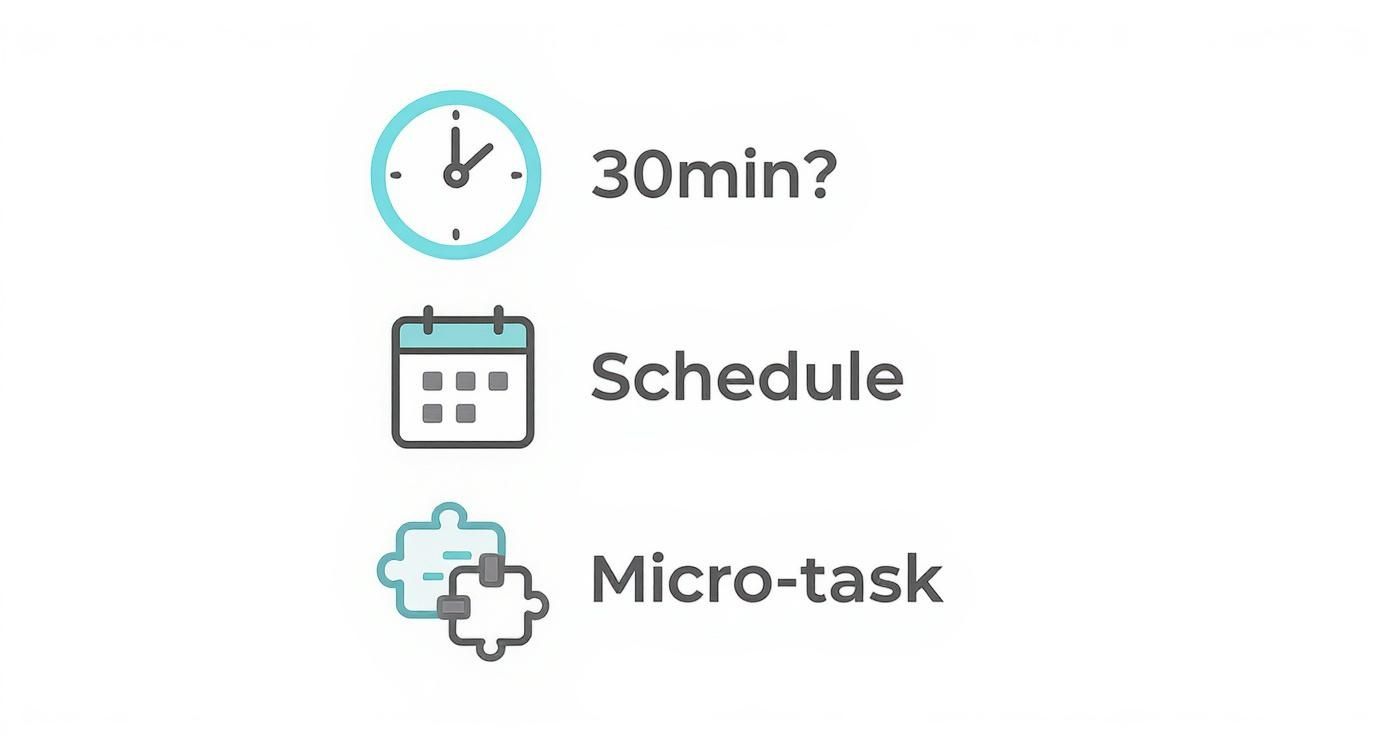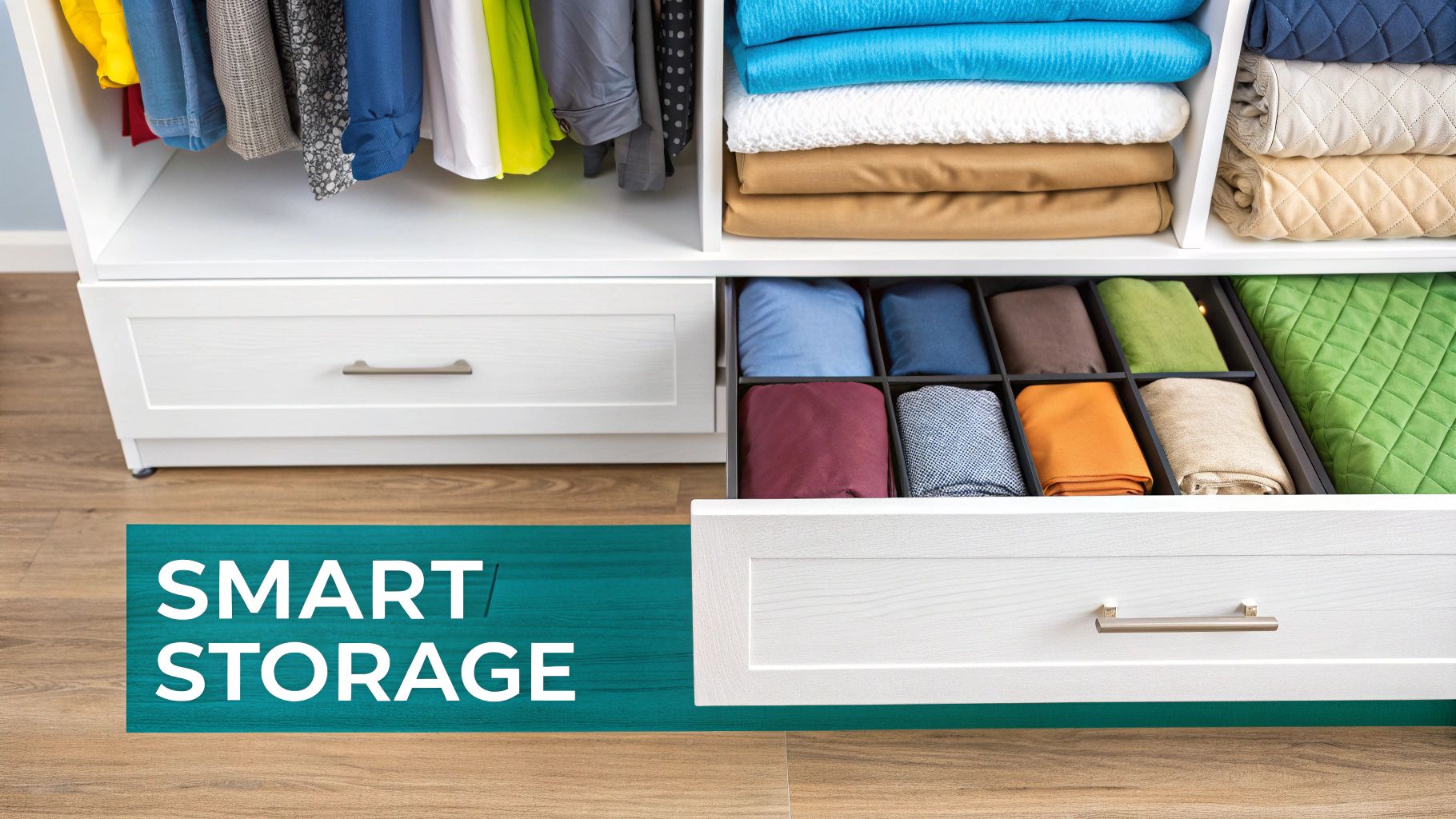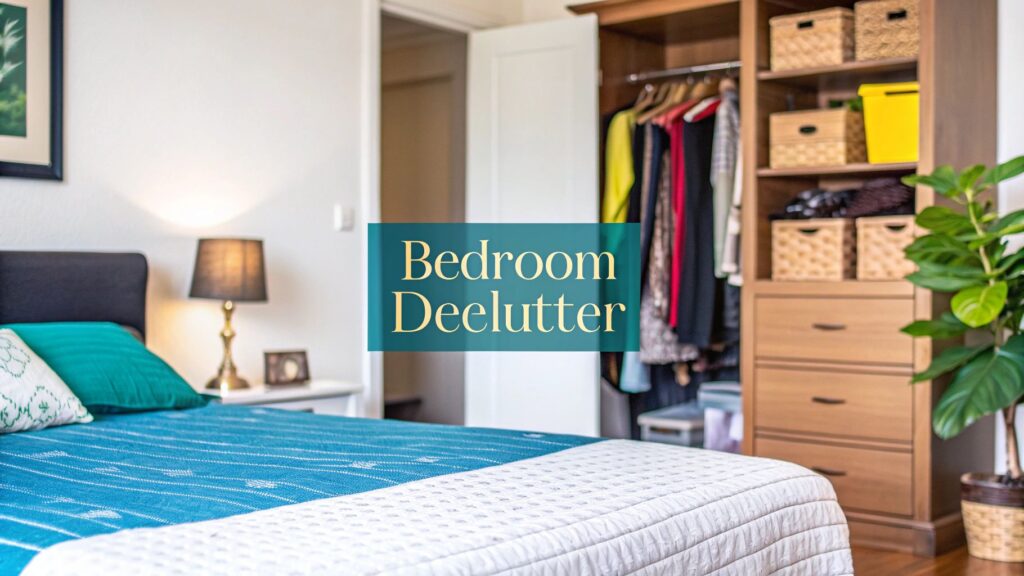The secret to successfully decluttering your bedroom? Start small and be ruthless. Seriously. Just focus on one tiny zone at a time, like your bedside table or that one drawer you dread opening. Then, apply a simple sorting system: keep, donate, or discard. This approach stops you from feeling overwhelmed and helps you build momentum.
Your Quick Guide to Bedroom Decluttering
A messy bedroom isn't just about looks; it can genuinely mess with your peace of mind and even cause friction in your relationships. It's a massive issue in the UK, where research shows 61% of households argue about clutter every month. What’s more, the average person is clinging onto around £514 worth of stuff they don't even use.
By mapping out a simple plan, you can turn your space from chaotic to calm without sacrificing an entire weekend. The trick is to picture the end goal—a serene, organised sanctuary. If you're really struggling to start, checking out resources that offer real help with decluttering your overwhelmed home can give you the push and the practical strategies you need.
Laying the Groundwork for a Tidy Room
Before you dive in and start pulling things out, it helps to get the basics right. The most successful decluttering projects break the room down into smaller, defined areas. This simple mental shift makes the whole thing feel far more achievable.
Think of it like this: instead of tackling 'the wardrobe', you're just dealing with 'the shoe rack'. It's all about small wins.
The image below shows a classic way to categorise your items as you go.

This method forces you to make a decision for every single item. It gets a clear destination—it stays, it's moved to another room, or it's out of your house for good. The goal is to make quick, confident choices for each object you pick up, one by one.
Building Your Decluttering Game Plan
Any successful decluttering project starts long before you pick up the first box. It’s all about creating a realistic plan that actually fits into your life, shifting your mindset from a huge, overwhelming chore to a series of smaller, more manageable wins. Forget blocking out an entire weekend; try scheduling short, focused 30-minute sessions instead.
This approach makes the whole process feel much less intimidating. For example, a busy parent could tackle an overflowing toy box by spending just 15 minutes a day on it for a few days. In the same way, a professional could clear out a single wardrobe drawer in the time it takes to drink their morning coffee.
It's completely normal to feel a bit apprehensive before you start. A recent survey found that while 42% of people felt enthusiastic about decluttering, nearly a third felt nervous. Breaking the project down into smaller chunks is the best way to get over that initial hesitation, as this helpful Good Housekeeping decluttering guide explains.
Prepare Your Tools for Success
Being prepared is half the battle. Before you even think about starting your first session, get everything you need together. Having your supplies ready to go means you can keep the momentum going without any interruptions and focus entirely on making those tricky decisions.
Your essential decluttering toolkit should include:
- Sturdy Bags: Using different coloured bags for different categories is a game-changer—one for rubbish, one for donations, and another for items that just need to be moved to other rooms.
- Cleaning Supplies: Keep cloths, a multi-surface spray, and a hoover handy. It’s the perfect time to clean shelves and drawers as you empty them.
- Labels and a Marker: Clearly label everything, especially if you plan on putting boxes into storage. This will save you a world of pain later when you’re trying to find something.
A well-organised toolkit is the foundation of an efficient declutter. It prevents interruptions and keeps you focused on the goal, turning a potentially chaotic process into a smooth and systematic one.
If you find you’ve got several boxes of things you want to keep but simply don't have room for, it’s a good time to think about your options. Using a simple storage calculator can help you picture how much space you might need for seasonal clothes, sentimental items, or hobby gear. It’s a great way to keep them safe without cluttering up your newly organised space.
Right, you’ve got your plan. Now it's time to get sorting. This part of the process is less about big, dramatic clear-outs and more about making a lot of small, focused decisions. The trick is to touch each item just once, decide its fate, and then move on. A simple way to keep yourself on track is the Four Box Method.
It’s as straightforward as it sounds. Grab four boxes or large bags and label them: Keep, Donate, Bin, and Relocate. Every single thing you pick up has to go into one of these piles straight away. It’s a great way to stop that dreaded "maybe" pile from forming, which is really just a sneaky form of procrastination.
Tackling Sentimental Items
Let's be honest, dealing with sentimental stuff is usually the toughest part of any decluttering project. What do you do with gifts you feel guilty for not using? Or clothes that don’t fit anymore but are tied to a great memory? The key is to learn how to separate the memory from the actual object.
To help you make the call, ask yourself a few blunt questions:
- Have I used this in the last year? If the answer’s no, you probably won’t use it in the next one either.
- Would I buy it again today for the full price? This is a great way to figure out how much you truly value it right now.
- Does it align with the person I am today? We all change, and it’s okay for our belongings to change with us.
If you’re stuck and only have a few minutes, this decision-tree infographic is a brilliant little tool for making quick choices.

This visual just proves that breaking the whole thing down into smaller, scheduled tasks makes it feel so much more manageable. It’s all about making steady progress, not hitting perfection in one go.
Responsible Disposal and Donations
Once your "Donate" and "Bin" boxes are full, it’s important to deal with them responsibly. Your unwanted things could make a massive difference to someone else, and getting rid of them properly is much better for the environment. Lots of UK charities even offer collection services for bigger donations, which makes life even easier.
Donating items you no longer need not only clears your space but also supports community initiatives and promotes a circular economy. It transforms your decluttering effort into a positive action for others.
For anything that can't be donated – think broken electronics or old batteries – have a look at your local council’s website to find specialist recycling points. Organisations like Recycle Now have easy-to-use locators for facilities all over the UK, so you can be sure your clutter is being handled in an eco-friendly way. This final step means your newly organised bedroom comes with a totally clear conscience.
Smart Organisation for a Tidy Bedroom
So, you've successfully sorted through everything. Now comes the fun part: smart organisation. This is more than just stuffing things back into cupboards. It's about creating logical, easy-to-use systems that stop the clutter from creeping back in. The real aim here is a bedroom that doesn't just look tidy but is genuinely simple to keep that way.
Effective organisation often starts with looking at your space differently. Think vertically. Wall shelves draw the eye upwards and make brilliant use of empty wall space. Or, look down. That often-neglected space under your bed is a goldmine. Stylish under-bed drawers or vacuum-sealed bags for your out-of-season duvet can free up a surprising amount of wardrobe space.

Maximise Every Inch
To really get a handle on bedroom organisation, you need to think inside the box—literally. Your wardrobes and drawers are prime real estate, but they can descend into chaos without a bit of internal help.
Simple additions can make a world of difference:
- Drawer Dividers: These are a lifesaver for conquering that infamous 'everything' drawer. They keep socks, belts, or makeup neatly separated and easy to grab.
- Vertical Shelf Inserts: Got a tall shelf in your wardrobe? Pop in an insert to instantly double the usable space, creating dedicated spots for jumpers, bags, or shoes.
- Hanging Organisers: These slim, fabric organisers that hang from the wardrobe rail are fantastic for storing shoes, folded t-shirts, or scarves without taking up any floor space.
When you're putting these ideas into practice, the focus should always be on making the most of the storage you have. For more inspiration, it’s worth exploring the top ways to maximize bedroom storage to see what might work in your own room.
But what about the bigger things? If you've got items you can't part with—like heirloom furniture or seasonal sports gear—but just don't have the room, it might be time to look at off-site options. Our guide on how to choose the best storage facility when moving house has plenty of useful tips that apply just as well to general decluttering.
"A place for everything, and everything in its place." This old saying is the absolute foundation of staying organised for good. When every item has a permanent, logical home, tidying up stops being a chore.
To help you decide which solutions might be the right fit, it’s useful to compare the cost against the capacity you get.
A Comparison of Bedroom Storage Options
The table below gives a quick overview of some popular choices, helping you weigh up your budget against your storage needs.
| Storage Option | Capacity | Approximate Cost (£) |
|---|---|---|
| Under-Bed Storage Boxes | Low – Good for seasonal clothes, shoes, or spare bedding. | £15 – £50 |
| Wardrobe Organisers | Medium – Varies; includes dividers, hanging shelves, and inserts. | £10 – £100+ |
| Freestanding Shelving | Medium to High – Excellent for books, decor, and folded items. | £40 – £200 |
| Chest of Drawers | Medium – Classic choice for clothing and personal items. | £70 – £400+ |
| Self-Storage Unit (Small) | High – Ideal for bulky furniture, sports gear, and boxes. | £15 – £30 per week |
Hopefully, this comparison gives you a better idea of the options available and helps you make a practical decision on how to reclaim your bedroom space effectively.
When To Consider Self Storage
After sorting through your belongings, you’ll often find a stack of items that aren’t ready for the bin or charity shop—but don’t belong in your freshly organised bedroom either. That’s when looking beyond your four walls makes perfect sense. Self storage isn’t just for house moves; it’s a straightforward way to reclaim your living space without losing what matters.
Picture real-life situations. Maybe you’re downsizing but can’t part with family heirlooms. Or perhaps your paddleboard and camping kit occupy half the room most of the year. These treasures deserve a home, just not under your bed every day.
Making A Smart Storage Choice
Security tops the list when choosing a unit. You’re not merely renting space—you’re entrusting precious items to someone else. Search for facilities featuring 24/7 monitored CCTV, bright lighting and secure keypad or fob entry.
Don’t forget the practical details:
- Unit Size: Only pay for what you’ll actually fill. A 25 sq ft unit often fits a garden shed’s worth of stuff or dozens of boxes.
- Packing Strategy: Use uniform, sturdy boxes and label each side. This simple step slashes retrieval time.
- Insurance Cover: Check the facility’s included level of protection. Reliable providers clearly outline top-up options, so you’re ready for the unexpected.
Using self storage correctly transforms it from a simple holding space into an extension of your home. It’s about creating a system that keeps your living areas serene while ensuring your valued possessions are safe, secure, and accessible when you need them.
For anyone in The Wirral and surrounding areas, you can explore local self storage options here:
https://shieldselfstorage.co.uk/self-storage/
A Few Common Decluttering Questions
Even the most organised person hits a snag when decluttering their bedroom. It’s completely normal. Let’s tackle some of the most common stumbling blocks that pop up so you can push through and get back on track.
How Do I Stay Motivated When I Feel Stuck?
We’ve all been there. You’re staring at a mountain of clothes or a box of old photos, and the motivation just evaporates. When that happens, the most important thing is to reconnect with your ‘why’.
Take a moment to remember what made you start this in the first place. Were you dreaming of a peaceful, calm sanctuary? Tired of the morning stress of not finding anything? Whatever your reason, hold onto it.
And if a whole wardrobe feels overwhelming, don’t tackle it. Just focus on one shelf or a single drawer. Those small wins create momentum and prove you’re making progress, which is what really matters.
It's easy to get bogged down, but remember that every single item you decide on is a victory. Celebrate these small achievements to keep your energy high and your focus sharp.
What Should I Do With Sentimental Items?
Ah, the sentimental stuff. This is almost always the trickiest part of any decluttering project. For precious items you absolutely can’t part with but don’t have room for, a dedicated ‘memory box’ is a fantastic solution.
Another great trick is to photograph items you love but don't need to keep physically. This preserves the memory and the feeling attached to it without taking up space. For larger heirlooms or collections, a secure self-storage unit gives them a safe home, keeping them protected without cluttering up your newly organised room.
Ready to find a secure home for your treasured belongings? Shield Self Storage offers flexible and affordable units to keep your items safe while you enjoy your clutter-free space. Find out more at Shield Self Storage.



